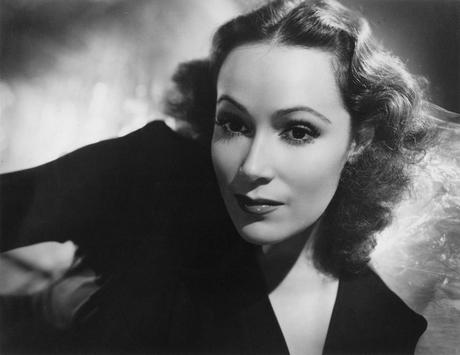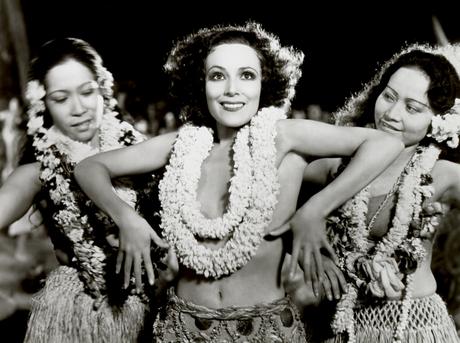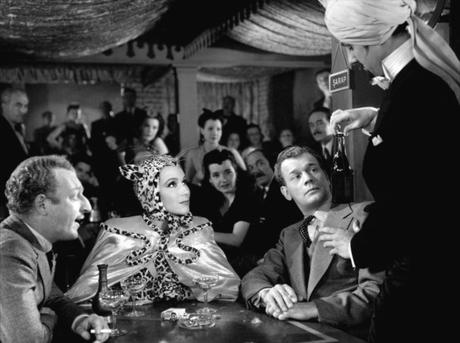
Today, Dolores del Rio is remembered as a pioneer who became the first Mexican actress to find mainstream success in Hollywood. Her film career began in 1925 and during the silent era, she appeared in hit movies like 1926’s What Price Glory?, 1928’s The Trail of ’98, and Ramona, also from 1928. In 1926, she was named a WAMPAS Baby Star, a distinction that put her in some very good company. That year alone, other WAMPAS Baby Stars included several up-and-coming legends, like Joan Crawford, Fay Wray, Mary Astor, Dolores Costello, and Janet Gaynor, just to name a few. But over the course of her career, she certainly encountered plenty of obstacles along the way.
As she entered the 1930s, Dolores del Rio had been dealing with a series personal and professional difficulties, but she ultimately attained a very enviable status within Hollywood. She had successfully made the transition from silent film to sound, with a new contract at RKO starting in 1931. She also married Cedric Gibbons, MGM’s legendary art director, in 1930 and they became one of the most high-profile couples in town, often seen out and about with the very top tier of Hollywood’s elite, like Douglas Fairbanks and Mary Pickford. Not only did they have their respective careers, their home was a very popular social destination.
During the time del Rio was under contract at RKO, the studio was working to revamp their public image. Even though they’d had their share of notable successes, they weren’t regarded in the same esteem as rival studios like MGM and they had some financial difficulties that needed to be dealt with. In hopes of turning things around, David O. Selznick was brought on as production chief and while his tenure at RKO lasted less than two years, it was a very important time for the studio. During this time, Selznick had a hand in bringing talent like Fred Astaire, Katharine Hepburn, and John Barrymore to the studio, as well as directors George Cukor and Merian C. Cooper. He was also involved with the production of one of RKO’s signature films: King Kong. On top of all that, he helped the studio cut production costs without significantly reducing output. But while this era in RKO history is generally regarded as being artistically great, it wasn’t enough for them to move past their financial problems and the studio went into receivership in 1933.

Dolores del Rio’s time at RKO under this contract was also rather brief. Her first movie was 1931’s Girl of the Rio, which didn’t make a splash with critics, followed by 1932’s Bird of Paradise. Bird of Paradise was a critical hit and proved to be just what she needed to re-establish herself as a major star. Not only was she coming off of the underwhelming Girl of the Rio, some health issues kept her off the screen for a while before that. But while Bird of Paradise put her back on top, it lost about $250,000. 1933’s Flying Down to Rio should have been an undeniable triumph for Dolores del Rio, but even though it was a big box office success, the first on-screen pairing of Fred Astaire and Ginger Rogers drew some of the attention away from Dolores and RKO’s financial situation meant that her contract was not renewed.
She quickly moved on from RKO and started work on series of films for Warner Brothers which gave them plenty of opportunities to showcase her as the height of glamour, including multiple films with Busby Berkeley. The first of these films, 1934’s Wonder Bar, was one of the biggest hits Warner Brothers had that year. She wasn’t the top-billed star, but she worked so well with Al Jolson that her part was expanded while Kay Francis, who was the top-billed star, saw her part get scaled back. But Wonder Bar would prove to be her last commercial high point in Hollywood for the 1930s.
After Wonder Bar, she started work on 1934’s Madame Du Barry, which provoked many heated disputes over its content. William Dieterle was brought on to direct and Dolores was excited about the project because it offered her something different from the usual types of movies she had been working on. But Joseph Breen’s office sent Warner Brothers a letter saying the script was, “filled with vulgarity, obscenity and blatant adultery” and stated that it would be a dangerous movie to make from the standpoint of industry policy. Local censor boards also objected and the movie was eventually redone without input from Dieterle, who thought the altered version didn’t do justice to del Rio’s comedic talents. Madame Du Barry went on to become a box office disappointment.

Next came 1935’s In Caliente, I Live for Love, and The Widow from Monte Carlo, with The Widow from Monte Carlo being her last film with Warner Brothers. Unfortunately, her last Warners film was not nearly as successful as her first. From Warner Brothers, she moved on to Universal to make 1937’s The Devil’s Playground and to 20th Century Fox for Lancer Spy and International Settlement, none of which made much of an impression on audiences.
By the time the Box Office Poison ad was published in 1938, citing Dolores as one of the movie stars who was failing to draw audiences into theaters, she was already well aware that it was time for a change. Movies like Bird of Paradise, Flying Down to Rio, and Wonder Bar were popular, but the roles weren’t particularly challenging for her. She had fewer opportunities to reinvent her image the way someone like Marlene Dietrich did when she made Destry Rides Again after she was also named Box Office Poison. Dolores had largely been relegated to playing glamorous, exotic types which were falling out of favor as World War II loomed on the horizon and reviews often tended to focus on things like her lavish costumes, her appearance, or her dancing skills rather than her talents as an actress. She knew being noted for those qualities was only going to become even more limiting as she got older.
Dolores had been toying with the idea of returning to Mexico long before the Box Office Poison ad was published. The Mexican film industry had been growing throughout the 1930s and when she took a trip home in August 1934, she was initially unsure about what type of reception she would receive. Even though she was a successful movie star, some of the movies she made had been criticized in Mexico. But she received a warm welcome which made it clear that leaving Hollywood for Mexico might not be such a bad idea. When she went to England to make 1936’s Accused with Douglas Fairbanks, Jr., she very much enjoyed the experience of working outside of Hollywood, further giving her reason to consider leaving.

In the early 1940s, she had begun an affair with Orson Welles, which ended her marriage to Cedric Gibbons and led to her appearing in 1943’s Journey Into Fear along with Joseph Cotton. But, as is the case for several of the movies produced by Orson Welles, Journey Into Fear had its problems during production. His work on The Magnificent Ambersons meant that Welles was unable to direct the film himself (although his involvement with the direction of Journey Into Fear is debatable) and some shooting had to be rushed because of his commitments for It’s All True. By the time the movie was in post-production, any influence Welles had on the final product was significantly diminished. The film’s release was delayed due to mixed reactions during test screenings and by then, RKO had fired Welles and he was only able to make limited changes. In the end, Journey Into Fear lost $193,000 and Dolores and Orson both found the final version to be an embarrassment.
Shortly after her work on Journey Into Fear was complete, Dolores dealt with the end of her relationship with Orson Welles, the death of her father, and she decided the time was right for her to return to Mexico. Even with all of her social connections, nearly 20 years of experience working in films, and a series of agents working on her behalf, she just wasn’t able to get quality roles in Hollywood anymore and arrived back in Mexico in August of 1942. Of the move, she stated:
“Divorced again, without the figure of my father. A film where I barely appeared, and one where they were really showing me the way of the art. I wanted to go the way of the art. Stop being a star and become an actress, and that I could only do in Mexico. I wish to choose my own stories, my own director, and camera man. I can accomplish this better in Mexico. I wanted to return to Mexico, a country that was mine and I did not know. I felt the need to return to my country.”
When she arrived back in Mexico, she did not have any films lined up, but it didn’t take long for her to start getting work in the Mexican film industry. Over the years, she went on to be nominated for five Silver Ariel awards, Mexico’s answer to the Academy Awards, winning three of them and one special award in recognition for her 50-year career as an actress. She would occasionally return to Hollywood to work in movies like 1947’s The Fugitive, 1960’s Flaming Star with Elvis Presley, and 1964’s Cheyenne Autumn, as well as appearing in a series of live theatrical productions. Her final role was in 1978’s The Children of Sanchez.
